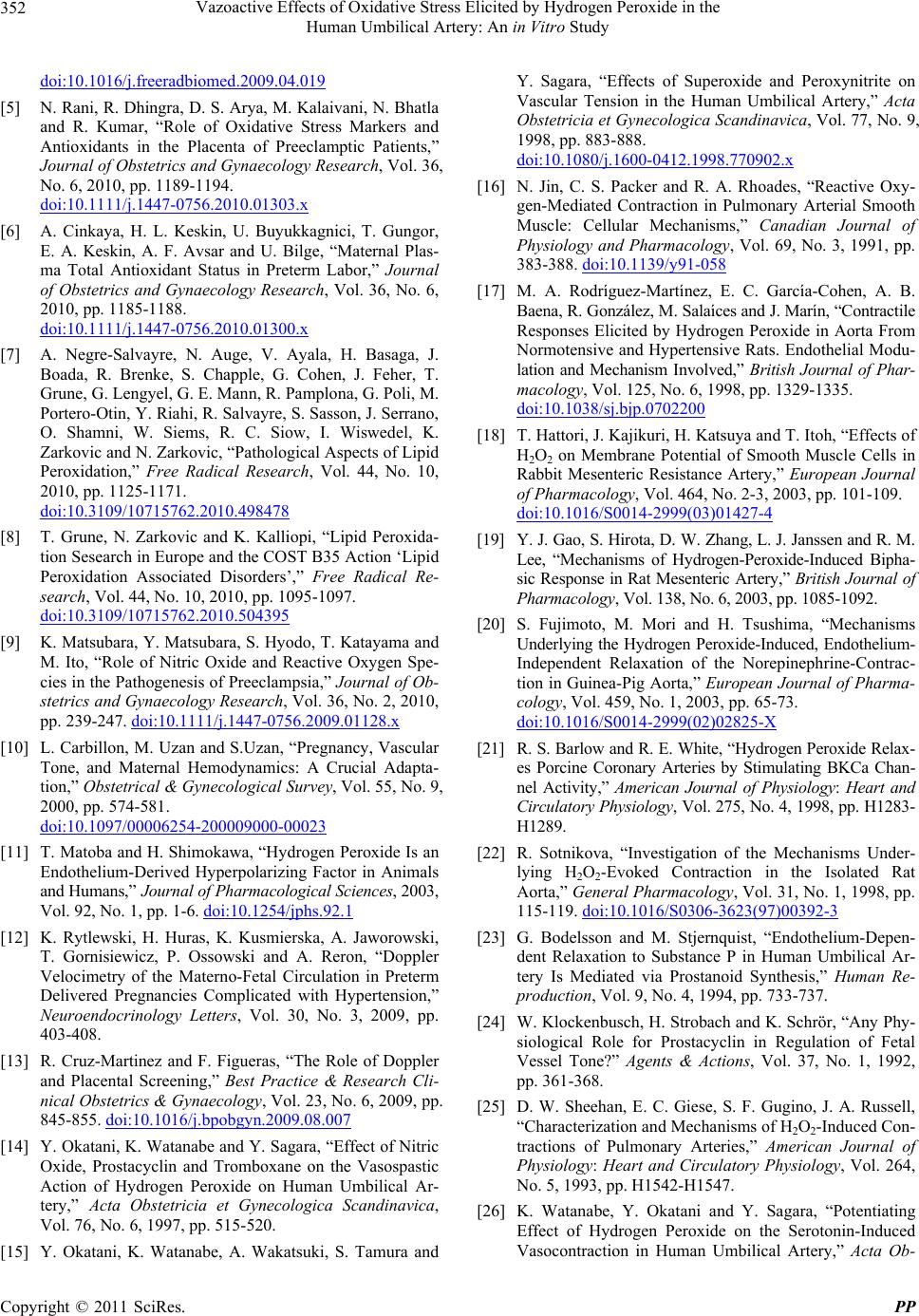
Vazoactive Effects of Oxidative Stress Elicited by Hydrogen Peroxide in the
352
Human Umbilical Artery: An in Vitro Study
doi:10.1016/j.freeradbiomed.2009.04.019
[5] N. Rani, R. Dhingra, D. S. Arya, M. Kalaivani, N. Bhatla
and R. Kumar, “Role of Oxidative Stress Markers and
Antioxidants in the Placenta of Preeclamptic Patients,”
Journal of Obstetrics and Gynaecology Research, Vol. 36,
No. 6, 2010, pp. 1189-1194.
doi:10.1111/j.1447-0756.2010.01303.x
[6] A. Cinkaya, H. L. Keskin, U. Buyukkagnici, T. Gungor,
E. A. Keskin, A. F. Avsar and U. Bilge, “Maternal Plas-
ma Total Antioxidant Status in Preterm Labor,” Journal
of Obstetrics and Gynaecology Research, Vol. 36, No. 6,
2010, pp. 1185-1188.
doi:10.1111/j.1447-0756.2010.01300.x
[7] A. Negre-Salvayre, N. Auge, V. Ayala, H. Basaga, J.
Boada, R. Brenke, S. Chapple, G. Cohen, J. Feher, T.
Grune, G. Lengyel, G. E. Mann, R. Pamplona, G. Poli, M.
Portero-Otin, Y. Riahi, R. Salvayre, S. Sasson, J. Serrano,
O. Shamni, W. Siems, R. C. Siow, I. Wiswedel, K.
Zarkovic and N. Zarkovic, “Pathological Aspects of Lipid
Peroxidation,” Free Radical Research, Vol. 44, No. 10,
2010, pp. 1125-1171.
doi:10.3109/10715762.2010.498478
[8] T. Grune, N. Zarkovic and K. Kalliopi, “Lipid Peroxida-
tion Sesearch in Europe and the COST B35 Action ‘Lipid
Peroxidation Associated Disorders’,” Free Radical Re-
search, Vol. 44, No. 10, 2010, pp. 1095-1097.
doi:10.3109/10715762.2010.504395
[9] K. Matsubara, Y. Matsubara, S. Hyodo, T. Katayama and
M. Ito, “Role of Nitric Oxide and Reactive Oxygen Spe-
cies in the Pathogenesis of Preeclampsia,” Journal of Ob-
stetrics and Gynaecology Research, Vol. 36, No. 2, 2010,
pp. 239-247. doi:10.1111/j.1447-0756.2009.01128.x
[10] L. Carbillon, M. Uzan and S.Uzan, “Pregnancy, Vascular
Tone, and Maternal Hemodynamics: A Crucial Adapta-
tion,” Obstetrical & Gynecological Survey, Vol. 55, No. 9,
2000, pp. 574-581.
doi:10.1097/00006254-200009000-00023
[11] T. Matoba and H. Shimokawa, “Hydrogen Peroxide Is an
Endothelium-Derived Hyperpolarizing Factor in Animals
and Humans,” Journal of Pharmacological Sciences, 2003,
Vol. 92, No. 1, pp. 1-6. doi:10.1254/jphs.92.1
[12] K. Rytlewski, H. Huras, K. Kusmierska, A. Jaworowski,
T. Gornisiewicz, P. Ossowski and A. Reron, “Doppler
Velocimetry of the Materno-Fetal Circulation in Preterm
Delivered Pregnancies Complicated with Hypertension,”
Neuroendocrinology Letters, Vol. 30, No. 3, 2009, pp.
403-408.
[13] R. Cruz-Martinez and F. Figueras, “The Role of Doppler
and Placental Screening,” Best Practice & Research Cli-
nical Obstetrics & Gynaecology, Vol. 23, No. 6, 2009, pp.
845-855. doi:10.1016/j.bpobgyn.2009.08.007
[14] Y. Okatani, K. Watanabe and Y. Sagara, “Effect of Nitric
Oxide, Prostacyclin and Tromboxane on the Vasospastic
Action of Hydrogen Peroxide on Human Umbilical Ar-
tery,” Acta Obstetricia et Gynecologica Scandinavica,
Vol. 76, No. 6, 1997, pp. 515-520.
[15] Y. Okatani, K. Watanabe, A. Wakatsuki, S. Tamura and
Y. Sagara, “Effects of Superoxide and Peroxynitrite on
Vascular Tension in the Human Umbilical Artery,” Acta
Obstetricia et Gynecologica Scandinavica, Vol. 77, No. 9,
1998, pp. 883-888.
doi:10.1080/j.1600-0412.1998.770902.x
[16] N. Jin, C. S. Packer and R. A. Rhoades, “Reactive Oxy-
gen-Mediated Contraction in Pulmonary Arterial Smooth
Muscle: Cellular Mechanisms,” Canadian Journal of
Physiology and Pharmacology, Vol. 69, No. 3, 1991, pp.
383-388. doi:10.1139/y91-058
[17] M. A. Rodríguez-Martínez, E. C. García-Cohen, A. B.
Baena, R. González, M. Salaíces and J. Marín, “Contractile
Responses Elicited by Hydrogen Peroxide in Aorta From
Normotensive and Hypertensive Rats. Endothelial Modu-
lation and Mechanism Involved,” British Journal of Phar-
macology, Vol. 125, No. 6, 1998, pp. 1329-1335.
doi:10.1038/sj.bjp.0702200
[18] T. Hattori, J. Kajikuri, H. Katsuya and T. Itoh, “Effects of
H2O2 on Membrane Potential of Smooth Muscle Cells in
Rabbit Mesenteric Resistance Artery,” European Journal
of Pharmacology, Vol. 464, No. 2-3, 2003, pp. 101-109.
doi:10.1016/S0014-2999(03)01427-4
[19] Y. J. Gao, S. Hirota, D. W. Zhang, L. J. Janssen and R. M.
Lee, “Mechanisms of Hydrogen-Peroxide-Induced Bipha-
sic Response in Rat Mesenteric Artery,” British Journal of
Pharmacology, Vol. 138, No. 6, 2003, pp. 1085-1092.
[20] S. Fujimoto, M. Mori and H. Tsushima, “Mechanisms
Underlying the Hydrogen Peroxide-Induced, Endothelium-
Independent Relaxation of the Norepinephrine-Contrac-
tion in Guinea-Pig Aorta,” European Journal of Pharma-
cology, Vol. 459, No. 1, 2003, pp. 65-73.
doi:10.1016/S0014-2999(02)02825-X
[21] R. S. Barlow and R. E. White, “Hydrogen Peroxide Relax-
es Porcine Coronary Arteries by Stimulating BKCa Chan-
nel Activity,” American Journal of Physiology: Heart and
Circulatory Physiology, Vol. 275, No. 4, 1998, pp. H1283-
H1289.
[22] R. Sotnikova, “Investigation of the Mechanisms Under-
lying H2O2-Evoked Contraction in the Isolated Rat
Aorta,” General Pharmacology, Vol. 31, No. 1, 1998, pp.
115-119. doi:10.1016/S0306-3623(97)00392-3
[23] G. Bodelsson and M. Stjernquist, “Endothelium-Depen-
dent Relaxation to Substance P in Human Umbilical Ar-
tery Is Mediated via Prostanoid Synthesis,” Human Re-
production, Vol. 9, No. 4, 1994, pp. 733-737.
[24] W. Klockenbusch, H. Strobach and K. Schrör, “Any Phy-
siological Role for Prostacyclin in Regulation of Fetal
Vessel Tone?” Agents & Actions, Vol. 37, No. 1, 1992,
pp. 361-368.
[25] D. W. Sheehan, E. C. Giese, S. F. Gugino, J. A. Russell,
“Characterization and Mechanisms of H2O2-Induced Con-
tractions of Pulmonary Arteries,” American Journal of
Physiology: Heart and Circulatory Physiology, Vol. 264,
No. 5, 1993, pp. H1542-H1547.
[26] K. Watanabe, Y. Okatani and Y. Sagara, “Potentiating
Effect of Hydrogen Peroxide on the Serotonin-Induced
Vasocontraction in Human Umbilical Artery,” Acta Ob-
Copyright © 2011 SciRes. PP